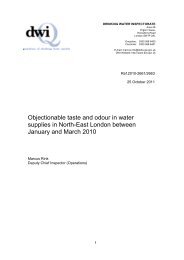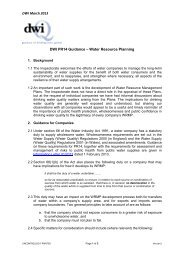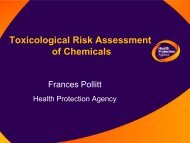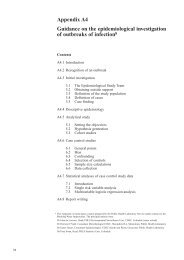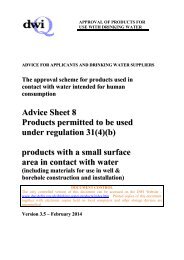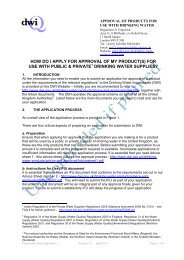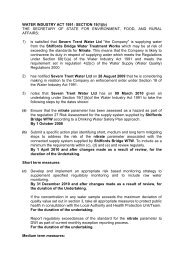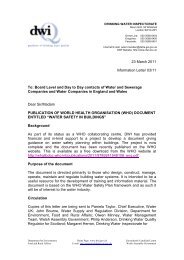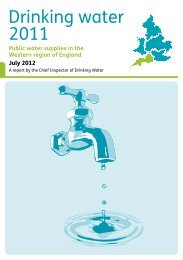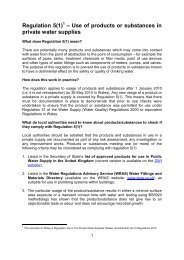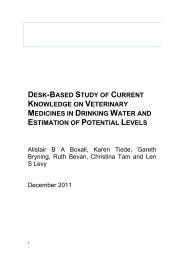(IFU) document - Drinking Water Inspectorate - Defra
(IFU) document - Drinking Water Inspectorate - Defra
(IFU) document - Drinking Water Inspectorate - Defra
Create successful ePaper yourself
Turn your PDF publications into a flip-book with our unique Google optimized e-Paper software.
APPROVAL OF PRODUCTS FOR<br />
USE WITH DRINKING WATER<br />
ADVICE FOR APPLICANTS<br />
The approval scheme for products used in<br />
contact with water intended for human<br />
consumption<br />
Advice Sheet 2<br />
Instructions for Use (<strong>IFU</strong>)<br />
DOCUMENT CONTROL<br />
The only controlled version of this <strong>document</strong> can be accessed on the DWI Website –<br />
www.dwi.defra.gov.uk/drinking-water-products.htm. Printed copies of this <strong>document</strong>, together<br />
with electronic copies held on local computers and other storage devices are uncontrolled.<br />
Version 4.9 – June 2012
UNCONTROLLED IF PRINTED<br />
INTRODUCTION<br />
This series of advice sheets has been prepared to help applicants understand the approval<br />
process for chemicals and construction products for use in contact with water intended for<br />
human consumption, and to explain what information they need to supply to the <strong>Drinking</strong><br />
<strong>Water</strong> <strong>Inspectorate</strong> (DWI) in seeking approval.<br />
The following advice sheets are currently available.<br />
Number Title<br />
1 Overview of the application process<br />
2 Instructions for Use (<strong>IFU</strong>) <strong>document</strong><br />
3 Treatment chemicals, filter media & ion exchange resins<br />
4 Changes to approved products<br />
5 Approval of products made from recognised materials & from metals<br />
6 Approval of membrane filtration systems & associated equipment<br />
7 Construction Products for <strong>Water</strong> Retaining Structures in <strong>Water</strong> Collection,<br />
Treatment and Distribution Systems<br />
8 Regulation 31(4)(b) – The approval and use of products with a small surface area in<br />
contact with water (including materials for use in well & borehole construction and<br />
installation)<br />
9 Emergencies – use of equipment and disinfectants<br />
10 Natural & traditional products<br />
AVAILABILITY<br />
Copies of the most up-to-date versions of these advice sheets can be freely downloaded from<br />
the DWI website – http://www.dwi.defra.gov.uk/drinking-water-products/advice-andapproval/index.htm<br />
APPLICATION FORMS<br />
A series of product type related applications forms are available from the DWI website –<br />
http://www.dwi.defra.gov.uk/drinking-water-products/advice-and-approval/index.htm<br />
LABORATORY TEST PROTOCOLS<br />
A series of product type related laboratory test procedures are available from the DWI website<br />
–http://www.dwi.defra.gov.uk/drinking-water-products/advice-and-approval/index.htm<br />
CONTACT<br />
For further information or help please contact us –<br />
Regulation 31 Enquiries, <strong>Drinking</strong> <strong>Water</strong> <strong>Inspectorate</strong><br />
Area 7e, 9 Millbank, c/o Nobel House, 17 Smith Square, London, SW1P 3JR, UK.<br />
Tel +44 (0)300 068 5029/6403<br />
E-mail : reg31.enquiries@defra.gsi.gov.uk<br />
Revision notes:<br />
Version 2.0 – major revision and additions throughout; Version 2.1 – additional requirements for units of measurement and a new check list for<br />
applicants; Version 2.2 – amendment to section 3.1; Version 2.3 – clarification on the use of decimal points and thousand “separators” – page 4<br />
Version 3 – new “introduction” section setting out the basic requirements, new section 5; Version 3.1 – addition of guidance on disinfection<br />
requirements and a list of useful <strong>document</strong>s<br />
Version 4.0 – addition of the new section 3, together with revisions to reflect new approval processes and requirements; Version 4.1 – minor<br />
amendments throughout, including specifically in 1 and 3 (6); Version 4.2 – addition of specific requirements for in-situ applied products (section<br />
5.2); Version 4.3 – clarification of acceptable uses of the product (sections 1 & 2, plus Table 4); Version 4.4 – additional requirements for emergency<br />
equipment (new Table 4, old Table 4 renumbered as “5; Version 4.5 – revision of Section 1”; Version 4.7 – clarification of installation requirements<br />
in Section 2 and Table 1, coverage of a range of related products (Section 2), revision of Table 5 and new Annex A. V4.8 address change. V4.9<br />
Correction of legislative references.<br />
Advice 2 – Instructions for Use Page 2 of 17 Version 4.9 June 2012
CONTENTS<br />
UNCONTROLLED IF PRINTED<br />
1 Introduction 5<br />
2 Content of the <strong>IFU</strong> 6<br />
3 Structure of the <strong>IFU</strong> 7<br />
4 Delays in processing applications 8<br />
5 Product specific information 9<br />
5.1 Stainless steel 9<br />
5.2 In-situ applied linings for water mains 9<br />
5.3 Other Products 9<br />
6 Submission of the <strong>IFU</strong> 10<br />
7 Useful reference <strong>document</strong>s 10<br />
TABLES<br />
1 Additional information requirements for general (non-metallic) construction<br />
products<br />
2 Additional information requirements for chemicals & treatment agents 12<br />
3 Additional information requirements for membrane systems (two tables) 13<br />
4 Additional information requirements for emergency equipment 15<br />
5 Check list for all Instructions for Use Documents. 16<br />
11<br />
ANNEX A Initial evaluation of <strong>IFU</strong> <strong>document</strong>s 17<br />
Advice 2 – Instructions for Use Page 3 of 17 Version 4.9 June 2012
GENERAL DEFINITIONS (for use with all Advice Sheets)<br />
UNCONTROLLED IF PRINTED<br />
The relevant regulations (for public drinking water suppliers)<br />
The following regulations apply to the approval of substances and products used in the provision of<br />
public water supplies within the United Kingdom:<br />
a) England - Regulation 31 of The <strong>Water</strong> Supply (<strong>Water</strong> Quality) Regulations 2000 (Statutory<br />
Instruments 2000 No 3184) –<br />
http://www.dwi.defra.gov.uk/stakeholders/legislation/ws_wqregs2000.pdf<br />
b) Wales – Regulation 31 of The <strong>Water</strong> Supply (<strong>Water</strong> Quality) Regulations 2010 (Welsh<br />
Statutory Instrument 2010 No 994 (W.99) –<br />
http://dwi.defra.gov.uk/stakeholders/legislation/wsr2010wales.pdf<br />
c) Scotland – Regulation 27 of The <strong>Water</strong> Supply (<strong>Water</strong> Quality) (Scotland) Regulations 2001 –<br />
http://www.opsi.gov.uk/legislation/scotland/ssi2001/20010207.htm<br />
d) Northern Ireland – Regulation 30 of The <strong>Water</strong> Supply (<strong>Water</strong> Quality) (Amendment)<br />
Regulations (Northern Ireland) 2009 (Statutory Rules of Northern Ireland 2009 No.246) -<br />
http://www.opsi.gov.uk/sr/sr2009/nisr_20090246_en_1<br />
Where reference is required to specific regulatory requirements, these are given in footnotes.<br />
The Authorities<br />
Under the relevant regulations water suppliers shall not apply or introduce any substance or product into<br />
public water supplies unless the requirements of the relevant regulations are met. One of these<br />
requirements is that the substance or product has been approved by either the Secretary of State for the<br />
Environment Food and Rural Affairs (England), the Welsh Ministers (Wales), the Northern Ireland<br />
Assembly (Northern Ireland) or the Scottish Ministers (Scotland) – collectively referred to as “the<br />
Authorities”.<br />
The List<br />
Under the relevant regulations lists of all the substances and products approved or refused, and of<br />
all approvals revoked or modified are published at least once a year –<br />
England and Wales –this list is regularly updated by DWI throughout the year, and<br />
includes details of changes to approved products and additions to the List; the list (the<br />
List of Products for use in Public <strong>Water</strong> supply in the United Kingdom) is posted on the<br />
DWI website: http://dwi.defra.gov.uk/drinking-water-products/approvedproducts/soslistcurrent.pdf<br />
Reference to “the List” throughout this publication refers to<br />
the most up-to-date version available from the website.<br />
Scotland – a list is published annually by the Scottish Government on their website:<br />
http://www.scotland.gov.uk/Publications/<br />
Northern Ireland – in due course the Department for Regional Development (Northern<br />
Ireland) will also publish a list.<br />
The approval of a product<br />
Approval is based upon consideration as to whether the use of a substance or product will adversely<br />
affect the quality of the water supplied, or cause a risk to the health of consumers; no consideration is<br />
given to fitness for purpose and approval by the Authorities must not be taken as a favourable<br />
assessment of the performance or merits of any substance or product. It is the responsibility of the end<br />
user to ensure fitness for purpose.<br />
The approval process for general products used with water intended for human consumption is set out in<br />
Advice Sheet 1. Relevant deviations from this process are set out in the appropriate Advice Sheets.<br />
<strong>Water</strong> suppliers<br />
These include water undertakers, inset appointees, and combined licensees - see The <strong>Water</strong> Act 2003<br />
(Consequential and Supplementary Provisions) Regulations 2005, together with private water suppliers.<br />
Advice 2 – Instructions for Use Page 4 of 17 Version 4.9 June 2012
UNCONTROLLED IF PRINTED<br />
MANUFACTURER'S OFFICIAL INSTRUCTIONS FOR USE (<strong>IFU</strong>)<br />
1. INTRODUCTION<br />
This is a very important <strong>document</strong>; products are considered, assessed and<br />
tested on the basis of your <strong>IFU</strong> and any final approval given makes it a legal<br />
requirement for the <strong>Water</strong> Company to adhere to the <strong>IFU</strong>.<br />
The <strong>IFU</strong> should be prepared taking into account the following essential requirements –<br />
a) It must be specific to the product for which approval is being sought<br />
b) It must be specific for use of the product with water intended for human consumption<br />
and written specifically for use by drinking water suppliers in the United Kingdom<br />
c) It should not refer to requirements in other countries, such as the USA or other EU<br />
Member States; the UK requirements should always be given, e.g. spelling, units of<br />
measure, labelling, together with transport, storage and disposal requirements etc.<br />
d) It must not refer to other uses for the product, including possible use in building water<br />
systems (apart from in the initial description of the product)<br />
e) It should provide all the necessary information to the purchaser/end user to enable them<br />
to use the product<br />
f) It must be self-contained, controlled dated <strong>document</strong> with full page numbering,<br />
together with full contact details<br />
g) It must not contain any advertising material<br />
h) It must not contain any company confidential information, or be marked “confidential”<br />
i) It must not refer to foreign standards – references should be to British Standards<br />
(including BS EN standards). If equivalent BS EN standards are not available the<br />
appropriate requirements should be quoted in full.<br />
In view of the importance of the <strong>IFU</strong> in the approval process you are<br />
strongly advised to seek the help of an experienced consultant in preparing<br />
this <strong>document</strong> for submission.<br />
<strong>IFU</strong>s that do not meet these essential requirements will be rejected as<br />
unsuitable and returned for revision.<br />
Remember the <strong>IFU</strong> is your set of instructions to the purchasers of the product,<br />
telling them how to install, commission and use your product with water<br />
intended for human consumption. It should not contain any other additional<br />
information.<br />
Advice 2 – Instructions for Use Page 5 of 17 Version 4.9 June 2012
2. CONTENT OF THE <strong>IFU</strong><br />
UNCONTROLLED IF PRINTED<br />
To avoid any delay to your application please make sure that your <strong>IFU</strong> is comprehensive, up to<br />
date and is based solely on the use of your product by water suppliers in the collection,<br />
treatment and supply of water intended for human consumption.<br />
Please submit a MS ® Word electronic copy of your <strong>IFU</strong> <strong>document</strong> together with the completed<br />
application form, to Regulation 31 Enquiries - reg31.enquiries@defra.gsi.gov.uk<br />
The content of the <strong>IFU</strong> will vary depending upon the nature of the product and the mode of use.<br />
As a minimum, however, the <strong>document</strong> MUST –<br />
be a formal, comprehensive self-contained <strong>document</strong> which is identified by title, issue<br />
number, date of issue and with full contact details (company name, address, telephone etc)<br />
with each page numbered sequentially. Please note – advertising literature, price lists etc.<br />
are not acceptable in this <strong>document</strong>.<br />
be product specific, but can cover a range of similar products of different dimensions made<br />
from the same materials/components and method of construction (the use of a generic or<br />
general purpose technical development manual for a range of products of differing<br />
composition or construction is NOT acceptable) – for specific guidance contact us<br />
relate specifically to the use of the product by water suppliers with water intended for<br />
human consumption and not refer to the use of the product elsewhere, including in building<br />
water systems<br />
indicate the proposed use of the product and the scope of this use<br />
specify the conditions of use which will apply when the product is approved<br />
units of measurement must be expressed in metric units - other units of measurement, such<br />
as gallons, pounds, inches and Fahrenheit, can be accepted in names/descriptions of<br />
products, e.g. (8 inch pressure pipes) or as alternative units, provided that they are<br />
contained within (brackets) after the metric unit<br />
include the accepted UK use of a full stop for a decimal point, and a comma as a separator<br />
for thousands, e.g. 234,000.5<br />
include details of any special pre-commissioning storage conditions<br />
describe how the product will be installed<br />
provide details of cleaning, testing, disinfection and commissioning in accordance with the<br />
“Principles of <strong>Water</strong> Supply Hygiene & Technical Guidance Notes” – (see section 7 of this<br />
Advice Sheet).<br />
provide details of routine checks on performance in operation<br />
specify general safe handling procedures and precautions<br />
disposal of cleaning, disinfection or commissioning chemicals (disposal protocol to be in<br />
line with Environment Agency policy)<br />
any other health and safety issues for the operator<br />
In addition, for Site Applied Products (including in-situ linings), it MUST –<br />
indicate methods of surface preparation<br />
include details of the use of primers and undercoats (if any), together with the relevant<br />
application details and curing conditions for these<br />
include details of the mixing process, including mixing ratios and how the mixing is<br />
undertaken (including for each layer of the complete coating systems)<br />
include details of the application process<br />
give details of curing conditions including cure period and temperature/cure curve<br />
include details of any known incompatibilities with potential substrates onto which the<br />
product could be applied<br />
include details of how repairs can be undertaken<br />
Additional product type specific information that must be included is given in Tables 1 to 4.<br />
Table 5 provides a checklist to help you in preparing your <strong>document</strong>.<br />
Advice 2 – Instructions for Use Page 6 of 17 Version 4.9 June 2012
3. STRUCTURE OF THE <strong>IFU</strong><br />
UNCONTROLLED IF PRINTED<br />
The text of the <strong>IFU</strong> should be set out in headed sections that reflect the sequence the user needs<br />
to follow in order to understand the proposed use of the product, its introduction into use,<br />
continuing operation and safeguards for drinking water quality, personal safety and avoiding<br />
harm to the environment. You are encouraged to set out the guidance in a logical sequence<br />
making use of headings and sub-headings, and using schematic drawings and photographs<br />
when these will help the user.<br />
An indicative structure is given below that will enable you to include all the elements set out in<br />
section 2 above and Tables 1 to 4 of this guidance, as appropriate for the product. It is<br />
emphasised that this guidance cannot be prescriptive due to the diversity of products and their<br />
uses.<br />
1. Description of the product<br />
Describe what the product is, including physical and chemical parameters.<br />
2. Description of product use<br />
Describe what the product is used for, including the scope and restrictions on use by drinking water<br />
suppliers 1 .<br />
3. Product Application<br />
Describe how the product is used. It will probably help the user if this section is set out with sub-sections<br />
which may include product packaging and delivery, assembly, component mixing, application methods,<br />
curing etc.<br />
If the product can only be applied or installed by specific contractors, this requirement will be included as a<br />
condition of approval. All contractors working on public drinking water suppliers sites or on behalf of them<br />
should have a valid National <strong>Water</strong> Hygiene Scheme ID card. The <strong>IFU</strong> should state such requirements and<br />
must also be complete in all other aspects to ensure that the water supplier can be assured that the product is<br />
applied/installed in accordance with the approval conditions.<br />
In addition, if the product will only be used by a private drinking water supplier, under the requirements of<br />
Regulation 5 of the Private <strong>Water</strong> Supply Regulations, this should be clearly stated in the <strong>IFU</strong>.<br />
4. Commissioning and/or preparing a product for use, including disinfection<br />
This will include instructions on any cleaning, flushing and disinfection routines, together with any checks<br />
and tests to ensure the product is fit to be put into use. As chlorine is commonly used for disinfection it is<br />
important that you describe any conditions on the maximum allowable exposure of the product to chlorine<br />
both by concentration and contact time.<br />
5. Operational Routines<br />
Any routine monitoring, performance checks and routine maintenance should be described. A detailed<br />
maintenance manual is not required but attention should be drawn to routine measures that need to be taken<br />
to ensure the satisfactory and effective use of the product. Procedures for the stopping and re-starting of<br />
product use should be included.<br />
6. Storage<br />
Conditions for product storage together with its shelf life should be described.<br />
7. Disposal of waste and spillage<br />
Instruction on the safe disposal of spillage and excess product should be given, taking into account the safety<br />
of personnel and avoidance of harm to the environment.<br />
1 including private water suppliers under the relevant regulations, e.g. Regulation 5 of the Private <strong>Water</strong> Supply Regulations<br />
2009 in England<br />
Advice 2 – Instructions for Use Page 7 of 17 Version 4.9 June 2012
4. DELAYS IN PROCESSING APPLICATIONS<br />
UNCONTROLLED IF PRINTED<br />
Poorly written or badly presented <strong>IFU</strong> <strong>document</strong>s are the major causes of delays in processing<br />
applications. Normally a product will not be considered by DWI for approval under the<br />
relevant regulations without a satisfactory <strong>IFU</strong>, and usually DWI will not agree to the release<br />
of any appropriate test requirements until they are completely satisfied with the <strong>IFU</strong>.<br />
Before you submit an <strong>IFU</strong> to DWI in support of an application make sure that it meets all<br />
of the requirements set out in Section 1 and, if appropriate, Tables 1 to 3; use Table 5 to<br />
help you ensure that your <strong>IFU</strong> meets our minimum requirements.<br />
NOTE: Annex A contains the check list we will use in the general review of your <strong>IFU</strong> – do<br />
check to ensure your <strong>IFU</strong> will meets these requirements BEFORE you submit it to us.<br />
After a successful outcome from this initial evaluation a further technical evaluation is<br />
undertaken.<br />
Make sure that your <strong>IFU</strong> is technically adequate and clearly written.<br />
Unfortunately neither the DWI nor its expert advisors can provide consultancy and help in<br />
preparing <strong>IFU</strong> <strong>document</strong>s, or in resolving issues relating to them.<br />
Final approval of your product, once any testing required has been completed, will always be<br />
dependent upon the prior receipt of a satisfactory <strong>IFU</strong>.<br />
Advice 2 – Instructions for Use Page 8 of 17 Version 4.9 June 2012
5. PRODUCT SPECIFIC INFORMATION<br />
UNCONTROLLED IF PRINTED<br />
5.1 Stainless steel<br />
If you wish to seek approval for stainless steel products you must provide an Instructions for<br />
Use <strong>document</strong> identified by title, issue number, date of issue and with full contact details<br />
(company name, address, telephone etc), and stating that your product should be used in<br />
accordance with the British Stainless Steel Association’s "Operational Guidance and Code of<br />
Practice for Stainless Steel Products in <strong>Drinking</strong> <strong>Water</strong> Supply" – available from the BSSA<br />
Website - http://www.bssa.org.uk/publications.phpid=25 . For further guidance see Section<br />
3.2 of Advice Sheet 5<br />
5.2 In-situ applied linings for water mains<br />
In-situ applied products must be applied in accordance with strict operational requirements as<br />
<strong>document</strong>ed in the <strong>Water</strong> Industry Information & Guidance Note IGN 4-02-02 "Code of<br />
Practice: In-situ resin lining of water mains” and the <strong>Water</strong> Industry Specification WIS 4-02-01<br />
“Operational Requirements: In situ resin lining of water mains"– both available from<br />
http://www.water.org.uk/home/member-services/wis-and-ign/current-<strong>document</strong>s. These<br />
<strong>document</strong>s refer to specific information that has to be included in the product Instructions for<br />
Use, e.g. –<br />
temperature parameters for components and rig, need for a heated umbilical cord,<br />
cleaning solvent(s) for rig and associated components, preconditioning procedures for<br />
transferring resin components at start and during lining,<br />
minimum cure times before CCTV inspection and before return to service<br />
5.3 Other Products<br />
If you are submitting any of the product types listed in the following tables (1 to 4), make<br />
sure your <strong>IFU</strong> includes the additional information requested.<br />
Advice 2 – Instructions for Use Page 9 of 17 Version 4.9 June 2012
6. SUBMISSION OF THE <strong>IFU</strong><br />
UNCONTROLLED IF PRINTED<br />
It is a requirement that the Instructions for Use <strong>document</strong>(s) is submitted electronically to the<br />
<strong>Inspectorate</strong> in MS Word ® or “rich text” format.<br />
If your <strong>IFU</strong> is not available electronically, you should discuss this with DWI BEFORE<br />
submitting it to –<br />
Regulation 31 Enquiries, <strong>Drinking</strong> <strong>Water</strong> <strong>Inspectorate</strong>,<br />
Area 7e, 9 Millbank, c/o Nobel House, 17 Smith Square, London, SW1P 3JR.<br />
Tel: +44 (0)300 068 5029/6403<br />
E-mail: reg31.enquiries@defra.gsi.gov.uk<br />
7. USEFUL REFERENCE DOCUMENTS<br />
Civil Engineering Specification for the <strong>Water</strong> Industry (2004: 6 th Edition) – published by WRc<br />
plc on behalf of UK <strong>Water</strong> Industry Research Ltd; ISBN 1 898920 51 6.<br />
Principles of <strong>Water</strong> Supply Hygiene & Technical Guidance Notes – Published by <strong>Water</strong> UK<br />
and available from – http://www.water.org.uk<br />
Advice 2 – Instructions for Use Page 10 of 17 Version 4.9 June 2012
UNCONTROLLED IF PRINTED<br />
TABLE 1. <strong>IFU</strong> – Additional information requirements for general (non-metallic)<br />
construction products.<br />
Product<br />
Pipes<br />
Tanks,<br />
reservoirs<br />
& pressure<br />
vessels<br />
Linings and<br />
coatings<br />
Additional information required<br />
- physical dimensions of the product range (using the same materials and<br />
methods of manufacture) for which approval is sought<br />
- storage conditions, including:<br />
maximum storage heights<br />
lifting and unloading<br />
packaging<br />
the use of end caps<br />
- installation instructions, including:<br />
laying<br />
bending<br />
jointing – mechanical, solvent welding, heat welding etc<br />
- pre-commissioning testing<br />
- commissioning instructions, including cleaning and disinfection<br />
- for lined pipe, instructions for repair of small defects prior to installation, and<br />
instructions for making good at joints and following future repairs.<br />
- any guidance needed concerning water types for which the pipes are suitable<br />
- physical dimensions and volumes of the product range (using the same<br />
materials and methods of manufacture) for which approval is sought<br />
- storage conditions, including:<br />
maximum storage heights<br />
lifting and unloading<br />
packaging<br />
- installation and assembly instructions including details of all ancillary<br />
equipment and components, e.g. :<br />
ladders, roof stays, access points<br />
jointing and sealing compounds used in assembly<br />
- pre-commissioning testing<br />
- commissioning instructions, including cleaning and disinfection<br />
- surface preparation,<br />
- use of primers and undercoats etc (if any)<br />
- packaging and identification of multi-component parts, including colour of<br />
each part and the finished lining/coating<br />
- details of the application process including-<br />
minimum temperature of application<br />
any environmental controls and humidity restrictions<br />
use of primers and undercoats<br />
- instructions for preparation of the product by the user including mixing<br />
proportions and pot life<br />
- curing conditions (period and temperature cure curve) when applicable<br />
Advice 2 – Instructions for Use Page 11 of 17 Version 4.9 June 2012
UNCONTROLLED IF PRINTED<br />
TABLE 2. <strong>IFU</strong> – Additional information requirements for chemicals & treatment agents.<br />
Product<br />
General<br />
requirements<br />
Chemicals<br />
Disinfectant &<br />
cleaning agents<br />
for water works<br />
apparatus &<br />
distribution<br />
systems<br />
Adsorbents, filter<br />
media, & ion<br />
exchange resins<br />
Electrochemical<br />
generating<br />
processes<br />
Additional information required<br />
- packaging and method of delivery<br />
- method of control of dosing<br />
- test method to determine chemical/dose strength<br />
- dealing with spillage and safe disposal of surplus product<br />
- routine monitoring of dose strength<br />
- storage conditions and timescale<br />
- any preparation before usage (e.g. dilution) and details of all<br />
commissioning procedures undertaken by the end user<br />
- the maximum and maintenance dosage rate<br />
- methods and point of dosing<br />
- disposal conditions<br />
- any preparation prior to usage (e.g. dilution) and details of all<br />
commissioning procedures undertaken by the end user<br />
- procedures to be adopted before the treated apparatus is returned to service<br />
(e.g. flushing)<br />
- the maximum and maintenance dosage<br />
- methods and point of dosing and method of monitoring the concentration in<br />
the water<br />
- disposal of waste product or water contaminated with the product<br />
- any restrictions on the use of the product which ensure that water supply<br />
does not become contaminated with the product<br />
- type of resin<br />
- details of media size, depth, capacity etc…<br />
- preparation of the filter bed<br />
- bed volume<br />
- bed conditioning procedures (flow rates, pH stabilization)<br />
- procedures for regeneration of the product<br />
- precautions to be taken during regeneration and re-commissioning<br />
- expected life-in-use<br />
- storage conditions<br />
- disposal of waste product (disposal protocol to be in line with Environment<br />
Agency policy)<br />
- all operational details, including full details of chemicals used<br />
- expected life of the generated product<br />
- disposal of waste products (disposal protocol to be in line with the<br />
Environment Agency policy)<br />
Advice 2 – Instructions for Use Page 12 of 17 Version 4.9 June 2012
UNCONTROLLED IF PRINTED<br />
TABLE 3. <strong>IFU</strong> – Additional information requirements for membrane systems.<br />
NOTE : labelled diagrams and photographs showing the construction of an element and a<br />
typical array of elements will help DWI understand how the system will be used. It is not<br />
desirable or necessary for applicants to provide DWI with a complete set of operating manuals<br />
for a filtration system. However, it may be appropriate to include abstracts from these manuals<br />
together with other information that will enable the end user to quickly assemble the product<br />
and operate it effectively.<br />
Table 3.1. Product Description<br />
Attribute<br />
Description of filter<br />
type<br />
Proposed use<br />
Preservation during<br />
delivery and storage<br />
Detailed requirements<br />
- filtration range, e.g. –<br />
microfiltration – pore size 0.05 to 10m<br />
ultrafiltration – pore size 2 to 100nm<br />
nanofiltration – pore size 0.5 to 2nm<br />
reverse osmosis<br />
- detailed explanation of the water type for which the unit has been<br />
designed, e.g. brackish, partially treated etc., together with a statement<br />
about the suitability of the system for use with chlorinated water<br />
- details of the preserving system(s) used<br />
Advice 2 – Instructions for Use Page 13 of 17 Version 4.9 June 2012
UNCONTROLLED IF PRINTED<br />
TABLE 3.2. Product installation, commissioning and use<br />
Stage<br />
Detail<br />
Installation<br />
- indicate the point of installation, including whether up-stream or<br />
down-stream of final chlorination point etc.<br />
Commissioning - the commissioning instructions should include –<br />
die-away curves which demonstrate the volume of water and<br />
rinsing times required to completely remove any traces of<br />
preserving fluids from the unit<br />
a means of verifying under plant conditions that removal of<br />
these fluids has been effectively carried out<br />
instructions for the safe disposal of these fluids<br />
Operation<br />
- operating pressure<br />
- typical flow rates (including minimum and maximum values)<br />
Backwashing and/or - typical volume of water treated before the membrane is taken out of<br />
cleaning<br />
service for cleaning<br />
- cleaning instructions should include (as appropriate) –<br />
details explaining when cleaning is required<br />
information about any cleaning chemicals used<br />
the procedures for removing cleaning agents before the unit is<br />
put back into supply<br />
the volume of raw or treated water to be used in backwashing<br />
and cleaning<br />
die-away curves for the removal of cleaning/disinfecting<br />
agents<br />
a means of verifying that under plant conditions removal of<br />
these agents has been effectively carried out<br />
instructions on the safe disposal of the dilute cleaning agent(s)<br />
- details of any on-line dosing of chemicals (e.g. descalants) and<br />
evidence of their removal<br />
Life of the membrane - typical life (volume of water treated, time etc.) before replacement is<br />
needed<br />
Safety<br />
Disposal of<br />
wastewater<br />
- detailed handling and operating instructions<br />
- how this will be achieved in service<br />
Advice 2 – Instructions for Use Page 14 of 17 Version 4.9 June 2012
UNCONTROLLED IF PRINTED<br />
TABLE 4. <strong>IFU</strong> – Additional information requirements for emergency equipment<br />
NOTE : a wide range of product types will be covered under this category. Only general<br />
guidance on requirements for the <strong>IFU</strong> can be given therefore; further detailed advice can<br />
be obtained from the Regulation 31 enquiries team.<br />
Attribute<br />
Description of<br />
product<br />
Cleaning &/or<br />
sterilisation before<br />
use<br />
Deployment<br />
One-use products<br />
Multi-use products<br />
Detailed requirements<br />
- nature of the product<br />
- proposed use<br />
- any critical storage requirements, including prevention of<br />
contamination<br />
- assessment of status before deployment, including state of packaging<br />
and any tamperproof seals etc<br />
- pre-cleaning<br />
- details of all procedures to be used<br />
- details of any assessment or test requirements before use, e.g. odour<br />
and flavour assessment, microbiological surface counts<br />
- how the equipment will be used, including details of all associated<br />
ancillary equipment required, whether provided with the product, or<br />
obtained locally, any specific labelling requirements, and length of<br />
service before redisinfection is necessary<br />
- how the product will be assembled, if appropriate, and tested before<br />
use<br />
- appropriate reference to Regulation 6(3) of the <strong>Water</strong> Supply (<strong>Water</strong><br />
Quality) Regulations 2000, and how the requirements of this will be<br />
met in use.<br />
- specific instructions that the product must not be re-used<br />
- instructions on disposal/recycling of the used product<br />
- relevant post-use cleaning and storage requirements<br />
- relevant commission requirements before re-use<br />
Advice 2 – Instructions for Use Page 15 of 17 Version 4.9 June 2012
UNCONTROLLED IF PRINTED<br />
TABLE 5. Check list for all Instructions for Use Documents.<br />
Please ensure that your Instructions for Use <strong>document</strong>s conforms with the following<br />
requirements –<br />
Has your company name and product name on it<br />
Is specific to the product (or range of related products 2 ) for which approval is sought, and<br />
not cover other products<br />
Is written in fluent English<br />
Has a version/issue number and date of issue<br />
Has each page numbered sequentially out of a total number of pages<br />
Is written specifically for water suppliers and exclusively for use with drinking water*<br />
Uses metric units for all measurements, other than in product names/descriptions, unless<br />
contained within brackets<br />
Includes all pre-commission conditions, including storage and handling<br />
Includes instructions on the disposal of waste substances (where appropriate)<br />
Includes all the relevant information specified in this Advice Sheet<br />
It must not contain any of the following information –<br />
advertising copy/literature, or manufacturers claims about the effectiveness of the<br />
product<br />
reference to or claims of "DWI approval"<br />
company confidential information, or be marked as “confidential”<br />
*Notes – your <strong>IFU</strong> must not -<br />
refer to use in water systems within buildings; this use is not within the requirements of<br />
the <strong>Water</strong> Supply (<strong>Water</strong> Quality) Regulations<br />
cover use with waste water<br />
be written for the "domestic market" – it must be written solely for use by drinking<br />
water suppliers<br />
refer to foreign standards – references should be to British Standards (including BS EN<br />
standards). If equivalent BS EN standards are not available the appropriate<br />
requirements should be quoted in full.<br />
If you fail to meet the basic requirements set out above, you will be asked to revise<br />
your Instructions for Use <strong>document</strong> and your application will be delayed until a<br />
satisfactory <strong>document</strong> is received.<br />
Annex A includes the question list we will use in the initial evaluation of your <strong>IFU</strong>.<br />
2 Differing only in dimensions or configuration, with no differences in composition or construction.<br />
Advice 2 – Instructions for Use Page 16 of 17 Version 4.9 June 2012
UNCONTROLLED IF PRINTED<br />
ANNEX A – INITIAL EVALUATION OF <strong>IFU</strong> DOCUMENTS<br />
A.1 Introduction<br />
After we have received your <strong>IFU</strong> we will carry out an evaluation of it. The first criteria to be<br />
considered, before any product specific ones, are set out in the table below. It is in your<br />
interest to ensure that all the relevant criteria set out in this table are adequately addressed in<br />
your <strong>IFU</strong>; failure to ensure this will delay the progress of your application.<br />
Criterion<br />
Does the <strong>IFU</strong> contain sufficient details of product application, curing and commissioning<br />
to enable the test conditions to be specified<br />
Is the product restricted to contact with chlorine-free water<br />
Does the <strong>IFU</strong> contain sufficient information to enable the application to proceed<br />
Evaluation<br />
Yes/No/na<br />
Yes/No/na<br />
Yes/No/na<br />
Is the <strong>IFU</strong> fully identified, pagenated and referenced, and free from advertising material<br />
Is the <strong>IFU</strong> free from reference to “DWI Approval” and to a specific DWI reference number<br />
Is the <strong>IFU</strong> specific to the product for which the application is made<br />
Is the <strong>IFU</strong> specifically for use by <strong>Water</strong> Companies and licensees, and their contractors<br />
Are the proposed uses and scope of use identified<br />
Are the conditions of use given and are they unambiguous<br />
Are units of measurement metric and are they unambiguous<br />
Are adequate packaging and storage conditions given<br />
Are safe handling procedures included<br />
Are adequate pre-commissioning conditions specified<br />
Are adequate instructions for cleaning given<br />
Are adequate instructions for testing (both pre- and in-service) given<br />
Are adequate and unambiguous commissioning instructions given<br />
Are appropriate in-service checks fully detailed<br />
Are adequate instructions included for the disposal of used/waste product<br />
Are there any Health and Safety issues of concern<br />
na = not applicable<br />
Yes/No/na<br />
Yes/No/na<br />
Yes/No/na<br />
Yes/No/na<br />
Yes/No/na<br />
Yes/No/na<br />
Yes/No/na<br />
Yes/No/na<br />
Yes/No/na<br />
Yes/No/na<br />
Yes/No/na<br />
Yes/No/na<br />
Yes/No/na<br />
Yes/No/na<br />
Yes/No/na<br />
Yes/No/na<br />
Advice 2 – Instructions for Use Page 17 of 17 Version 4.9 June 2012



